Mobile Satellite Devices

Providing reliable mobile satellite communications to special forces and other units operating on small vessels during operations on the shores of seas and rivers is a very difficult task due to extreme pitching and rolling and vertical movements
Although mobile satellite communications, also known by the abbreviation Sotm (Satcom-On-The-Move - satellite communications in motion), is also available for hand-held devices around the world, at all latitudes, thanks to the grouping of Iridium from 66 commercial satellites, but it is limited to low speeds data transfer from 2,4 to 10 kbps. For high-bandwidth satellite communications, higher frequencies are needed, namely, in the UHF band (from 300 MHz to 3 GHz), X band (8 - 12 GHz), Ku band (12 - 18 GHz) and Ka band (26,5 - 40 GHz). It also requires antennas with a high coefficient of effort and a narrow beam directivity, which must be precisely directed to the satellite at any given time. This is a major technical issue in the design of vehicle-mounted systems that need to keep in touch while driving over rough terrain.
Such systems became available several years ago. But the first systems were large, heavy and expensive, they had protruding antenna fairings, which made vehicles equipped with satellite communications, obvious goals and limited their access to equipped parking in urban areas. In addition, there is high demand for military satellite communications bandwidth with limited supply. Therefore, the new satellite constellation, along with innovations in mobile ground equipment, ranging from low-profile antennas to the transfer of satellite communication waveforms to programmable radio stations, causes a joyful revival among the military.
“Based on the experience gained and the analysis of the fighting, number one in the documented list of deficient communications for the mobile fighter is mobile communications out of direct line of sight,” said Captain Paul Gizel in September 2013 of the year in his review of the newest narrowband UHF satellite communications system, known as Muos (Mobile User Objective System). Captain Gizel heads the naval administration for satellite communications programs PMW146.
As MUOS demonstrates growing opportunities, the development of mobile terminals for a wide range of users of this narrow-band next-generation satellite system is gaining momentum. The command of the 22 spaceborne and naval systems of the January 2014 of the year requested information from the industry on the Muos terminals as part of the preparation for the demonstration of Over-The-Air (OTA) wireless communications at the end of March and related terminal tests. This is sure to whet the appetites of companies such as Harris and General Dynamics C4 Systems, which recently demonstrated the potential of Muos in mainstream mobile radio stations.
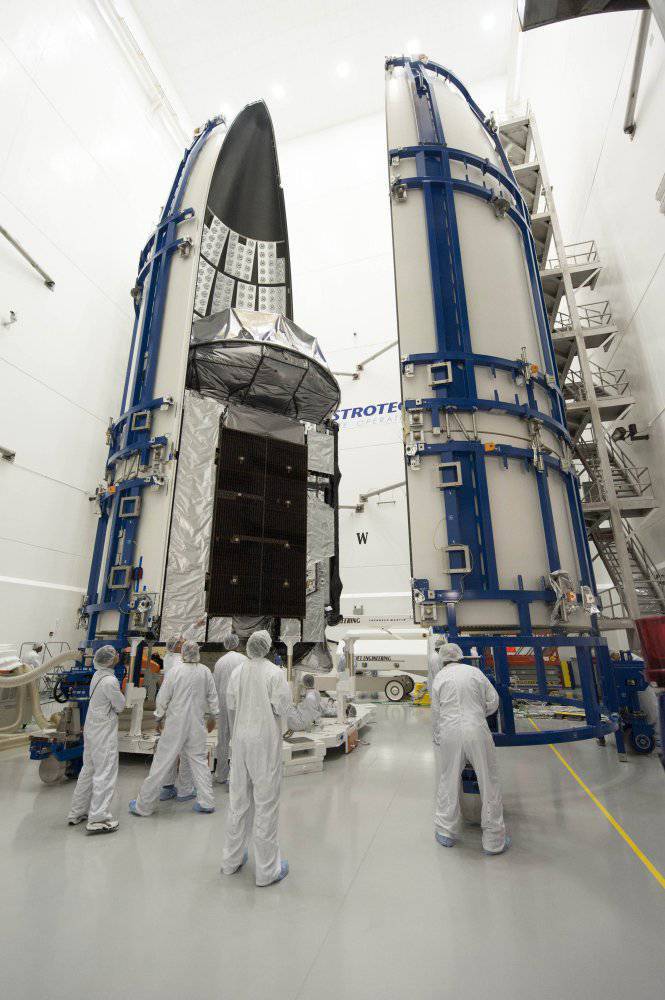
The Muos 2 satellite of the US Navy, enclosed in a streamlined capsule with a diameter of five meters, before docking with the Atlas V rocket. Muos is a next-generation tactical satellite communications system designed to expand the mobile communications capabilities of the American and allied forces
AN / PRC-155 Backpack Radio Station from GD C4 Systems, into which you can download Muos satellite communications protocols. Laboratory tests in August 2013 of the year showed that it can connect AN / PRC-154 infantry station to a Muos communications satellite
Backpack radios from the company GD C4S communicate with MUOS satellites
15 on November 2013 of the year GD C4S announced that its two AN / PRC-155 backpack radios successfully exchanged speech and data via Muos satellites in equatorial orbits; Muos wave patterns were uploaded to these programmable radios. At the latitudes of the Arctic and Antarctic, connecting with satellites in geostationary orbit is a problem because they are very close to the horizon. As the Earth flattens near the poles (the shape of an oblate spheroid), in some areas on its surface, satellites in this orbit become invisible.
“The PRC-155 Manpack radio station was the first and only military radio station that transmitted low-temperature and harsh Arctic winds through encrypted voice messages and data using the Muos system from the highest latitudes of the planet,” said Chris Marcilli, president of General Dynamics C4 Systems.
During this demonstration, held in mid-October, several scenarios were worked out, which General Dynamics describes as “realistic operational scenarios from fixed points of contact near Anchorage and Cape Barrow in Alaska and from the aircraft flying along the Arctic Circle”. Using a two-channel radio station, AN / PRC-155, several single-channel voice and data sessions were conducted in addition to a conference call with more than five participants. Data rates up to 64 kbps were demonstrated.
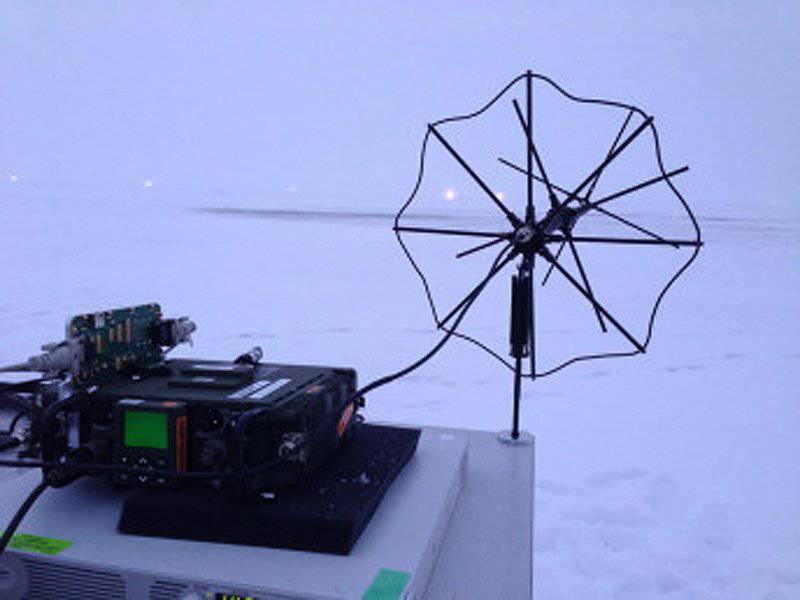
The AN / PRC-155 knapsack radio station has demonstrated its ability to connect with Muos at high Arctic latitudes from both contact points on the ground and from the aircraft. During the demonstration in October, there were several sessions of voice messages and data, as well as a conference call with more than five participants
It was the latest test in a series of tests, during which General Dynamics established its backpack and hand-held radio stations with the Muos constellation. In August 2013, the company established an AN / PRC-154 infantry radio station connection with the Muos satellite through the AN / PRC-155 backpack radio station. This happened after the April tests of encrypted data and speech transmission from one radio station to another via the Muos system, based in turn on the first demonstration of a similar connection in February 2012 of the year, in which the satellite simulator and the AN / PRC-155 radio station with loaded Muos templates participated.
Connection FALCON III with MUOS
Shortly thereafter, Harris announced the successful 2 communication of December 2013 of its AN / PRC-117G Falcon III multi-band radio station with Muos satellites. These tests also took place beyond the Arctic Circle, in a region that is experiencing a shortage of military UHF communications. This time, the Falcon III radio station was on board a transport aircraft that was flying from Alaska to the North Pole and back. According to Harris, more than 30 000 deployed AN / PRC-117G radio stations are ready to accept Muos software as an upgrade.
Phased array terminal ALICO
While phased array antennas have become quite common in radar systems, they are relatively rare in the communications world. However, Alico Systems introduced this technology into its Broadband Distributed Aperture satellite communications terminal, the details of which the company published in June 2013. The illustrations for this X-band system show four small rectangular plate-plate antennas mounted at the top of the chassis in the case of a tank M1 Abrams and BMP M2 Bradley and around the sunroof of the Navistar MaxxPro armored car.
Alico Systems has implemented phased array technology in its new Broadband Distributed Aperture system. Four low-profile antennas are designed to provide hemispherical coverage and autonomous orientation due to electronic beam control
Satellite Terminal Broadband Distributed Aperture from Alico Systems on the Bradley BMP (top) and M1 Abrams MBT
This is an extremely successful design of a broadband satellite dish system that adds nothing to the silhouette of the car and which, as they say in the company, eliminates any blocking of signals that could be caused by a tower or a load at the top of the car or could happen on specific directions when installing more traditional systems. As stated by Alico, this implies a full hemispherical coating from zero degrees (horizon) to 90 degrees (zenith) and continuous coverage from 0 degrees to 360 degrees in azimuth. In the system operating autonomously, an electronic beam control function is implemented, which directs both the beam and tracks the satellite with a frequency of 100 Hz, that is, the system updates its calculations of the relative position of the 100 satellite once a second.
Distributed phased array antennas also eliminate the problems of "keyhole" and "jamming of the universal joint". The first problem is related to the stabilization of electromechanical antenna systems, which have a viewing angle of elevation (range of vertical angles) less than 90 degrees, which leaves the sky area near the zenith of the potentially uncovered antenna beam. The second problem is related to the fact that in systems with a viewing angle of elevation of more than 90 but less than 180 degrees, there is a violation of continuous tracking when the satellite passes the zenith, when the universal joint reaches its limit vertically and the azimuth joint must turn to 180 degrees for follow up tracking. Wider beams can alleviate this problem, but keenly directed antennas have a narrow beam aperture, which forces them to compromise. With some overlap between the zones served by phased antenna arrays, the transition between them is easily controlled electronically.
Full-duplex systems are designed to process voice messages, data, and stream video in motion; They can work with a number of satellite groups, including the American Wideband Global Satcom (WGS) and XTAR, the Spanish SpainSat and the British Skynet. The system weighs 68 kg, consumes 700 watts, either at 115 AC volts or 28 DC volts.
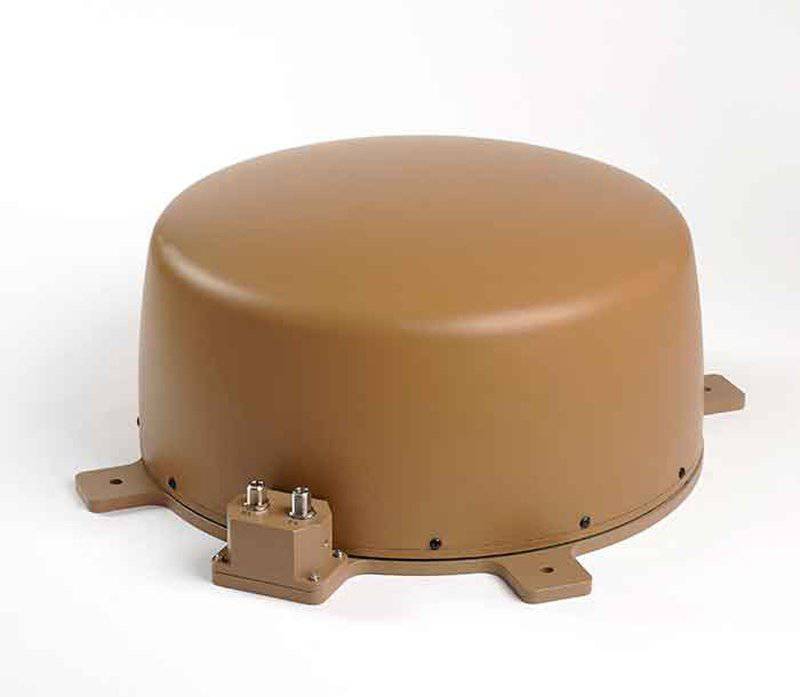
The new Ebitat 2000E terminal from Elbit uses an innovative passive waveguide panel. It has a diameter of 50 cm, mass 15 kg offers the speed of receiving data from the 30 satellite Mbps and transmission to the satellite 5 Mbps, as well as a triple tracking mechanism that provides reliable communication during movement
Antenna ELBIT ELSAT 2000E
Based on its MSR-2000 family, Elbit Systems at the DSEI fair in London in September 2013 introduced the new generation 2000E antenna. The new model significantly exceeds the previous Elsat 2000 terminal. Elsat 2000E provides full coverage in the Ku range; This terminal uses a new waveguide flat panel technology, which the company describes as a significant improvement in performance compared to the multi-element technology with emitters on a printed circuit board used in Elsat 2000.
The Elsat 2000E antenna has a diameter of 50 cm and a mass of 15 kg. The characteristics of the new antenna are twice as high as those of its predecessor with the same form factor. Elbit reports 30 Mbps satellite speeds and 5 Mbps satellite speeds.
The main feature on which the company focuses is an advanced triple tracking mechanism with an elevation angle of 100 degrees, which improves tracking and re-capture while moving. The company claims a noise temperature coefficient of G / T of seven dB / K (decibel / degree Kelvin), which is basically an indicator of the signal-to-noise ratio that an antenna can achieve. The higher the coefficient, the better it extracts a weak signal from the background noise.
Like the larger Elsat 2100 antenna, based on the same technology, 2000E integrates with the Elbit InterSky 4M military satellite communications platform, which provides seamless connectivity in direct view, indirect visibility and in the over-the-horizon mode.
According to a representative from Elbit, in order to obtain the maximum viewing angle, a flat panel antenna with mechanical scanning is combined in the system. “It provides an 360 ° circular view zone and a vertical sector from zero to 100 degrees, which is very different from other systems. Usually you have a complete plate at your disposal, which has the best directional coefficient, but a very high profile, which makes it easier for the enemy to find it. ”
Terminal range X from the company Ibetor
Low profile, as the desire of designers to the minimum visibility, is the main feature of the new terminal Ib-Sotm 100X range X, which the Spanish company Ibetor showed at the Satellite 2014 exhibition in Washington. The antenna has a height of just 20 cm, it has good aerodynamic efficiency and low visibility, while at the same time offering an effective and reliable connection in conditions that the company describes as “the most difficult terrain”.
Terminal Ib-Sotm 100X is designed for installation on ships, aircraft and ground vehicles. It includes the antenna control unit Antenna Control Unit (ACU) developed by Ibetor, consisting of an inertial measurement unit Inertial Measurement Unit (IMU), dual GPS receivers operating on one kHz, triaxial gyroscopes, accelerometers and magnetometers. This combination of devices provides the claimed accuracy of pointing less than 0,3 degrees, the capture of the satellite when the vehicle is moving and the “instantaneous” re-acquisition, including through software that holds the antenna with a mechanical scan in the direction of the satellite even if the signal is blocked. The following key parameters are stated for this antenna: the instantaneous frequency of the 500 MHz frequency, the G / T ratio of the 7,5 dB / K and the transmission rate to the satellite up to 8 Mbit / s in the center of the beam. Depending on the configuration, the Ib-Sotm 100X terminal weighs from 75 to 80 kg. The system is already in service with the Spanish military.
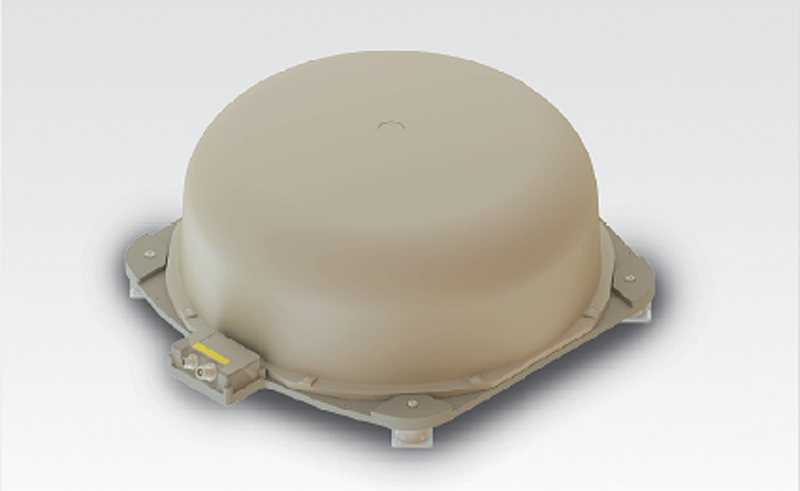
The low-profile RaySat StealthRay 300X-M antenna from Gilat Satellite Networks is 55,6 cm long, 49 cm wide, 25 cm high and 15 kg in weight. The antenna control unit installed inside the machine adds another 4,5 kg, but if it is not possible to add this unit, the antenna can be used with the integrated MLT-1000 modem
INDRA Alternative
The Sotm device from the Spanish company Indra works in the X and Ku bands, has a low-profile antenna as an option and is distinguished by built-in inertial navigation. The system provides satellite communications services for patrols through IP radio stations, as well as a high-bandwidth communication channel for brigade and battalion-level echelons. Indra also emphasizes that the device is intended for installation on any type of vehicle and even small vessels. Additional options include an extended Ku range from 13,75 to 14,5 GHz, encryption, an uninterruptible power supply that provides 20 minutes of continuous operation, and an on-board generator capable of supplying more than 10 hours of power.
GILAT SR300X-M
Following the system from Ibetor, another low-profile terminal appeared. March 11 Israeli company Gilat Satellite Networks showed its RaySat StealthRay 300X-M. The StealthRay 300X-M terminal is designed to work with any X-band satellite, including WGS. It consists of several motion sensors, which, when the vehicle is moving over rough terrain, allow minimizing the time of the initial satellite acquisition, maintain accurate tracking and carry out an “instantaneous” second capture.
The system is designed for easy installation on unprepared machines; it consists of an external antenna with a length of 55,6 cm, a width of 49 cm and a height of 25 cm and a mass of 15 kg.
Antenna Control Unit (ACU) internal antenna control unit of a smaller size weighs another 4,5 kg. However, the SR300X-M can work with the integrated MLT-1000 modem, which eliminates the need for an ACU.
For its new product, Gilat announces a G / T factor equal to 2 dB / K, corresponding to the gain in transmitting and receiving 23 and 25 dBi. The antenna receives in the 7,25 – 7,75 GHz band and transmits in the 7,9 – 8,4 GHz band. The SR300 family also includes low-profile antennas for Sotm applications in the Ku and Ka bands.
Exelis Gnomad provides communication with military and civilian satellites. The system is based on a low-profile antenna that offers speeds up to 2 Mbps.
DRS X46-V certification
After certification of the X46-V terminal for use with high-capacity satellite networks of the US Department of Defense announced last May by the company, DRS Technologies can now provide access to the global information network Global Information Grid (GIG) for isolated and distributed military units in the X range. . Released by the joint development center Satcom and the command of the strategic forces of the army, the mandate allows X46-V users to connect to the Wideband Global Satcom system (WGS) with the ability to transmit voice, data and video at speeds up to 6 Mbps. In addition to US troops, the military of Australia, Canada, Denmark, Luxembourg, the Netherlands and New Zealand can use the WGS faction. In addition, working in the Ky and Ka bands allows them to use other commercial and military satellite networks in order to increase functional flexibility and redundancy.
L-3 Linkabit, which manufactures various Sotm terminals, has received an updated Alsat Permanent Mobile Earth Station license to operate its Ku-band terminals with all official US satellites and other commercial devices; The company announced this in August 2013. The terminals covered by this license are L-3 Datron FSS-4180-LP tracking aerials with a small aperture meter (0,33xXNNUMX meter) or FSS-0,46-LC (4180 meter in diameter), as well as a Linkabit MPM-0,46 Satellite Communications Modem Modem IP. The US Army uses the terminals of L-1000 in its automated communications system for the operational-tactical management of the Warfighter Information Network - Tactical (WIN-T) and the marine corps in its Network On-The-Move system.
GNOMAD on STRYKER
Exelis has integrated the Gnomad system (Global Network On the Move Active Distribution) into an armored car Stryker, thereby setting the battle-tested system onto another key platform of the American army. The first installation was carried out during the seventh experiment to improve the combat operations of the expeditionary forces, held in Fort Benning. Exelis Gnomad is easy to install and does not require machine modifications.
The system consists of a satellite antenna, radio frequency components and a basic modular chassis, which can be installed on a variety of military vehicles, including the Humvee, as well as on commercial vehicles. The low-profile antenna (114,3x88,9x17,78 centimeters) weighs less than 38,55 kg with a base chassis that adds another 25,31 kg; It can work with both military and commercial satellites. Gnomad has an open architecture, that is, it can work in conjunction with many radio stations and satellite modems, providing full-duplex voice, data, and in the case of modems also video.
When connected to UHF and VHF radio stations, such as Sincgars and a built-in GPS receiver, the system allows you to directly integrate your own data into the overall operational picture. Transmission is carried out at frequencies from 14,0 to 14,5 Hz, and reception at frequencies of 10,95 – 11,7 GHz or 11,7 – 12,75 GHz. Gnomad offers data rates up to 512 kbps and receive rates up to 2 Mbps. The G / T coefficient is a minimum of 8 dB / K at a vertical angle of 30 degrees and a temperature of 23 ° C.
Terminal SWE-DISH from Rockwell Collins
As a result of the integration of the Swe-Dish CommuniCase Technology terminal from Rockwell Collins and the platforms stabilized along the four axes from Saab, the Sotm terminal was created, designed to work under difficult conditions at sea and land. It can be installed on various vehicles, ranging from light SUVs and small boats to mobile control points and medium landing craft. In all these applications, high speeds and movement in different planes make the installation and maintenance of satellite communications a very difficult task. The company Rockwell Collins notes that the system can safely handle large waves at ship speeds up to 50 nodes and on rough terrain at machine speeds over 40 km / h, automatically restoring the lost communication channel within one second and providing broadband at speeds up to 10 Mbps. Rockwell Collins claims a complete system weight of about 140 kg, a G / T ratio of 19 dB / K at 20 degrees of elevation, and 11 GHz.
Thales solutions operate in the X, Ku and Ka bands and offer the possibility of connecting the Venus French program to combat network radio systems, such as the VHF PR4G network.
THALES bulletproof version
For the first time, the French army deployed its Sotm systems in Afghanistan in 2010, and also used the equipment developed by Thales in Mali, which was mainly installed on VAB wheeled armored personnel carriers. These systems, in X, Ku, and Ka configurations, provide troops deployed in remote and unfamiliar areas with continuous voice, data, and video. These Sotm systems also provide long-distance communications with combat networks. For example, in the case of the program of the French army, Venus is basically a VHF PR4G network, although they are also easily integrated with UHF and VHF systems. The active antenna (and Thales was one of the first to apply phased array technology in its products) with “incomparable” tracking characteristics when traveling off-road, modern communication protocols, jamming resistance, counter-transmitters to combat improvised explosive devices and even bullet-proof antenna fairing provides sustainable and reliable satellite communications.
The possibilities of mobile satellite communications attract many innovations and, undoubtedly, many more new systems will come to this area.
Materials used:
www.monch.com
www.gdc4s.com
www.harris.com
www.alicosystems.com
www.elbitsystems.com
www.ibetor.es
www.gilat.com
www.exelisinc.com
www.thalesgroup.com
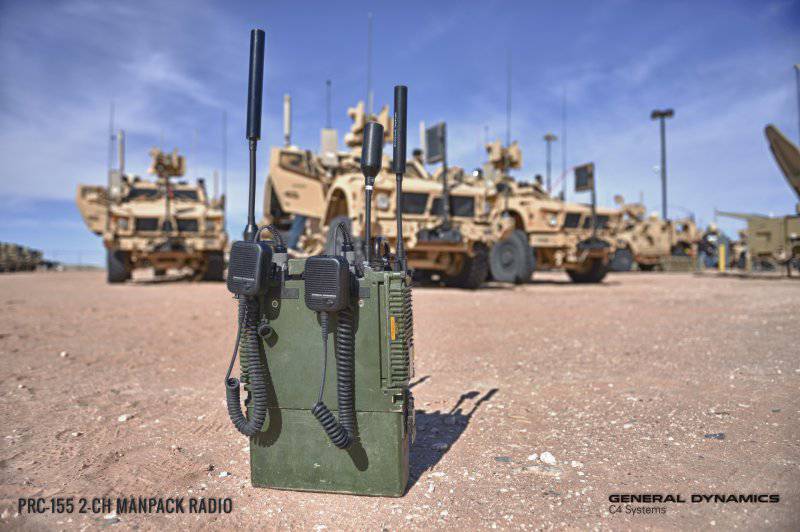
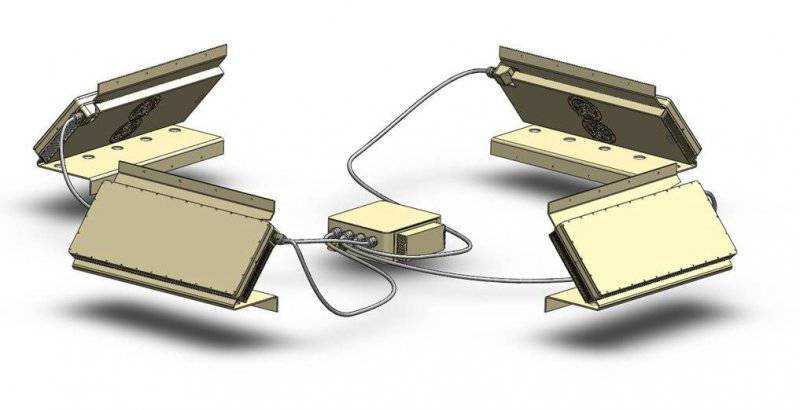
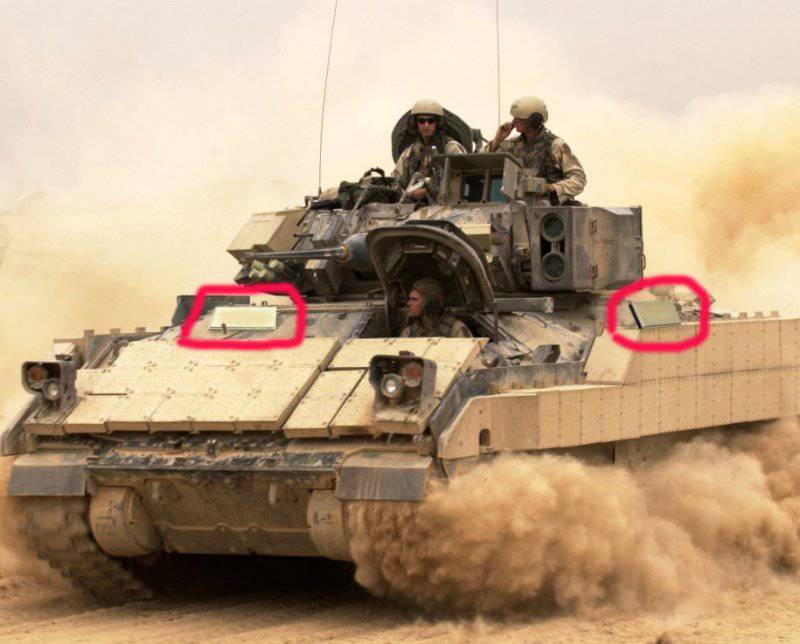
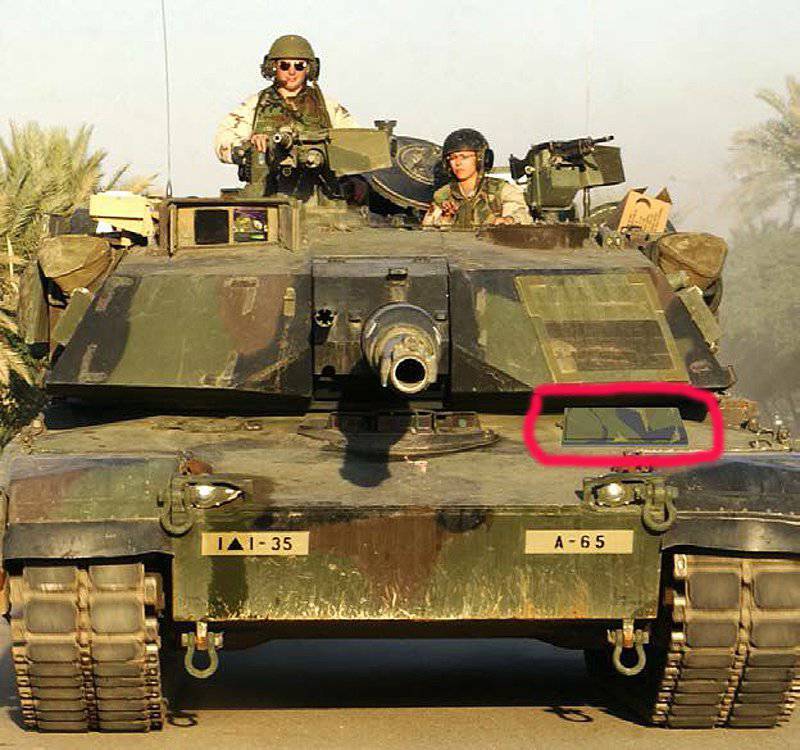

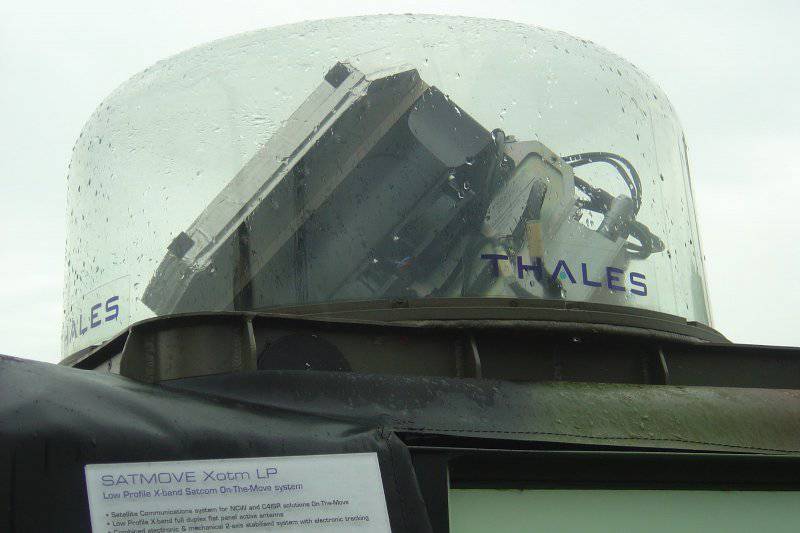
Information